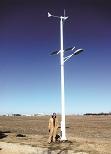

Turning Waste into Resources
Businesses that turn waste such as manure or sustainable vegetation into energy and other bio-based products are thriving throughout the country.
Genera Energy, located outside of Knoxville in Vonore, Tennessee, is involved in all aspects of the supply chain for biofuels, biopower and bio-based industries. The company uses sustainably grown biomass energy crops such as switchgrass using land not generally suitable for food crops.
It grew out of the University of Tennessee Research Foundation in 2008. Along with operating a cellulosic Ethanol biomass refinery, it has a biomass innovation park that focuses on supply side as well.
“This location is ideal for Genera Energy because the Southeast region is a tremendous source of this affordable, sustainable biomass – with the emphases being on sustainable. We don’t want to compete with prime cropland or material that has other high-value uses. Plus, we value the collaboration opportunities with University of Tennessee and the nearby Oak Ridge National Laboratory,” said Genera Energy President and CEO Kelly Tiller.

In central Missouri’s Moberly area, several businesses are taking advantage of the abundant manure from the many farms and turning it into energy and other byproducts.
“Azztec is in the testing stages of taking animal manure and separating the liquid to be used as a fertilizer and the remaining solid to be pressed in to pellets to be used as a bio-fuel to be burned for heating,” said David Gaines, vice president at the Moberly Area Economic Development Corporation.
“We take waste products which would otherwise be considered hazardous, such as chicken manure, and convert them into reusable commodities,” said Azztec CEO Paul Koenig. “Through PH manipulation, we steer most of the valuable fertilizer nutrients and metals into the liquid while leaving a biomass cake. That cake is now a clean burnable that can be converted to clean energy.”
The company’s first test pilot project was located just outside of Moberly in Monroe City, Missouri. Besides ready access to the biomass, Koenig said a big draw to the region is a high-quality workforce with reasonable wages, access to two international airports and the state’s aggressive export program for these clean energy pellets.
In Triplett, Missouri, also part of the Moberly region, Hampton Alternative Energy grew out of the Hampton Feed Lot. Hampton Alternative Energy collects manure from 2,400 head of cattle and uses an induced blanket reactor anaerobic digester to turn that into methane gas. It then uses a generator to turn the methane into electricity that powers the feed lot, with the excess being sold to Kansas City Power and Light. The byproduct is sold as a beneficial fertilizer for organic farming.
Biomass Power also Provides Security by Reducing Reliability on the Grid
In southwest Georgia’s Dougherty County, a unique landfill gas-to-energy project takes methane gas from a local landfill and converts it to electricity to power the Marine Corps Logistics Base (MCLB) in Albany, Georgia.

The plant is being run in conjunction with Chevron Energy Solutions, which developed, designed and managed construction of the plant and will maintain the landfill gas-to-energy facility, pipeline and processing equipment.
"This project offers significant benefits to the Department of the Navy, the Marine Corps and Dougherty County," said Col. Terry V. Williams, commanding officer, MCLB Albany. "Chevron Energy Solutions has helped us surpass federal renewable energy goals in our pursuit of becoming the ‘greenest’ Marine Corps installation in the nation. Not only does the use of this renewable power improve the base’s energy security and reliability, it also creates a valuable long-term source of revenue for the county. This is a win-win-win.”
Business and Innovation Driving Biomass
As seen with Genera Energy, business development and the heavy-duty backing from research institutions is helping to make clean industry a viable and profitable sector.
In Knoxville, Tennessee, not far from Genera Energy’s headquarters, the Cherokee Farm Innovation Campus is in development. Backed by approximately $100 million in capital investment and infrastructure, the site is attracting companies that can benefit from the campus’ direct connections with the University of Tennessee’s Joint Institute for Advanced Materials and the nearby Department of Energy’s Oak Ridge National Laboratory (ORNL).
“This research and development business campus offers unprecedented access to the most powerful tools available in materials science and high-performance computing, coupled with access to internationally renowned researchers in a variety of specializations,” said Cliff Hawks, president and CEO of the Cherokee Farm Innovation Campus. “It will spur further clean industry development in the area.”

Wind and Solar Energy is Still Making an Impact
Wind energy is another staple of clean industry initiatives, from manufacturing the parts to energy generation.
Ponca City, Oklahoma, 90 minutes northwest of Tulsa, has several wind projects taking advantage of the area’s abundant wind. The area’s local Kaw Nation tribe is partnering with four other tribes to develop a 90-turbine wind farm on tribal trust lands in Chilocco, Oklahoma, about 20 miles from Ponca City. It’s expected to add 153 megawatts of power to the Southwest’s grid.
Oklahoma ranks sixth overall in wind capacity and wind power totals 10.5 percent of the state’s total electrical generation.
The Kaw Nation created Southwind Energy and is also partnering with Ponca City to assemble and install wind and solar-powered lighting in the area, including lighting for large parking lots in shopping, medical and business centers.
“Designed to operate with no line voltage, trenching or metering, the units will offer significant benefits over traditional grid-based electrical lighting [thereby] reducing pollution, power consumption and carbon dioxide emissions,” said Katherine Long, marketing and research coordinator at the Ponca City Development Authority.
Ken Luttrell, director of public relations with the Kaw Enterprise Development Authority (KEDA), said, “The KEDA has been excited to bring innovative alternative energy technology to the area. The Kaw Nation, known as The Wind People, has a long heritage and relationship with the south wind and a commitment to renewable green energy.”

Communities – And Businesses -- Also Focusing on Clean
Not wanting to be left behind on the economic and environmental benefits of clean industry, communities throughout the U.S. are also going green.
One such area is College Park, Georgia. Located right outside of Atlanta, the small city of 14,000 actually has part of Hartsfield-Jackson Atlanta International Airport, the world's busiest airport, within its borders.
Several years ago, it installed Treepod Biofilters, a storm water filtration system developed by Santa Rosa, California-based KriStar Enterprises. Trees are planted on top of storm drains to cleanse storm water runoff of pollutants before entering the larger drainage system. In this case, the filtered water goes directly to a golf course pond and is used to irrigate the golf course.
College Park also partnered with Clean Energy Fuel to develop the Southeast’s large compressed natural gas (CNG) fueling station in 2008. Because the station is open to both commercial vehicles and the public, it fuels everything for airport shuttles to UPS trucks to refuse trucks.
At the grand opening, Interim City Manager Jim Smith said, “This new station is a golden opportunity not only to help improve local air quality, but to help save on fuel costs.”
“College Park is being responsible by embracing clean technology and working with business owners on how they can go green,” said Gerald Walker, College Park’s public information officer. “Even though we’re a small city, we’re making a big splash in terms of clean industry technology.”

One College Park entity that is following in step with the city’s clean focus is Woodward Academy, the largest independent school in the continental United States. The school purchases units of green power from local utility College Park Power.
Woodward Academy began its support of clean industry initiatives with the LEED construction of its Jordan N. Carlos Middle School campus in 2003. It then continued with the LEED silver construction of its Joseph H. Moss Math and Science Hall in 2007.
“We feel an obligation to be an example to our students, parents and community of good stewards of sustainability,” said Kelly Sanderson, vice president for finance and administration and CFO at Woodward Academy. “We pay the premium for green power through the City of College Park, which is funded through our operating facilities budget.”
In Ponca City, Oklahoma, the Ponca City Development Authority created a “Lighten the Load Program.” It partnered with U.S. Energy Recovery to help area businesses reduce energy cost through the installation of energy efficient lighting. Nine companies took advantage of the program in 2012 and more are on board for 2013.
“These companies also quality for rebates from the local energy company and Federal tax credits back at end of the year. It’s a win-win situation,” said Katherine Long.
And in Albany, Georgia, in Dougherty County, a MillerCoors brewery located there was an early, enthusiastic adopter of green practices.
“The plant, which is one of Georgia’s heaviest water users, is replacing older water-treatment technology with UV sterilization, which will save water and energy,” said Bárbara Rivera Holmes, director of marketing and existing industries at the Albany-Dougherty Economic Development Commission. “It has replaced keg-room refrigeration units with lower ozone-depleting fluorescent fixtures and replaced older high-energy, high-mercury lamps with new high-bay fluorescent fixtures. To top it off, the plant recycles or reuses 99.9 percent of its waste products.”

Thirty seven states have implemented renewable portfolio standards, which is also driving the push toward clean industry initiatives. This includes mandates that public utilities have a portion of their energy come from renewable sources.
“You’ll see growth opportunities as the technology grows,” said Will Cox, senior associate at Hickey & Associates, a site selection and public incentive management company. “For example, solar photovoltaic is coming close to the $1 per watt magic number, so you’ll see more homes and retail capacities integrated with smart grid technologies, which is a natural fit for cost savings. Ultimately, clean industry initiatives just make sense, offering good, high-paying jobs that have applications in other industries and spin-off opportunities.”
“Sustainability initiatives have become a major driver in business and economic development. Companies are realizing that clean industry and sustainability initiatives are affecting companies’ bottom lines. It has become more than recycling. Companies are being sustainable by focusing on innovation, lowering costs, increasing productivity and saving consumers money. Clean industry is supporting this drive for sustainability,” added Cliff Hawks at the Cherokee Farm Innovation Campus.
Related Agencies
- Albany/Dougherty Economic Development
- Moberly Area Economic Development Corporation
- Georgia Department of Economic Development
- Tennessee Department of Economic & Community Development
- Knoxville Oak Ridge Innovation Valley
- Knoxville Airport Authority
- Ponca City Development Authority
- Greater Oklahoma City Chamber - Economic Development
- Rural Enterprises of Oklahoma, Inc.
- College Park Economic Development
- Cherokee Farm Innovation Campus at the University of Tennessee

